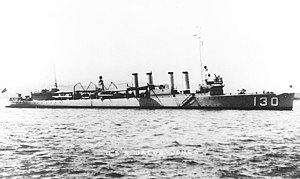USS Jacob Jones (DD-130)

USS Jacob Jones in the 1930s
|
|
| History | |
|---|---|
|
|
|
| Name: | Jacob Jones |
| Namesake: | Jacob Jones |
| Builder: | New York Shipbuilding Corporation, Camden, New Jersey |
| Laid down: | 21 February 1918 |
| Launched: | 20 November 1918 |
| Commissioned: | 20 October 1919 |
| Recommissioned: | 1 May 1930 |
| Decommissioned: | 24 June 1922 |
| Fate: | Sunk in battle, 28 February 1942 |
| General characteristics | |
| Class and type: | Wickes-class destroyer |
| Displacement: | 1,090 tons |
| Length: | 314 ft 5 in (95.8 m) |
| Beam: | 31 ft 8 in (9.7 m) |
| Draft: | 8 ft 8 in (2.6 m) |
| Speed: | 35 knots (65 km/h) |
| Complement: | 113 officers and enlisted |
| Armament: |
|
USS Jacob Jones (DD-130), named for Commodore Jacob Jones USN (1768–1850), was a Wickes-class destroyer. Jacob Jones was laid down by the New York Shipbuilding Corporation at Camden, New Jersey on 21 February 1918, launched on 20 November 1918 by Mrs. Cazenove Doughton, great-granddaughter of Commodore Jones and commissioned on 20 October 1919, Lieutenant Commander Paul H. Bastedo in command. She was sunk by a German submarine in 1942 during World War II.
Jacob Jones was decommissioned on 24 June 1922 and placed in reserve until recommissioned on 1 May 1930, and was assigned to Neutrality Patrol duties out of Charleston, South Carolina on 4 April 1940.
After fitting out at Philadelphia, Jacob Jones sailed 4 December for shakedown in the Atlantic Ocean. She arrived at Pensacola, Florida on 22 December to continue her training and departed on 3 January 1920 for the Pacific Ocean. Arriving at San Diego on 26 January, she operated along the California coast on anti-aircraft and firing exercises. She entered Mare Island Navy Yard 17 August for repairs and overhaul and assumed a reserve status. Returning to duty with Destroyer Force, Pacific Fleet, 18 June 1921, she operated out of San Diego until decommissioning 24 June 1922.
...
Wikipedia
